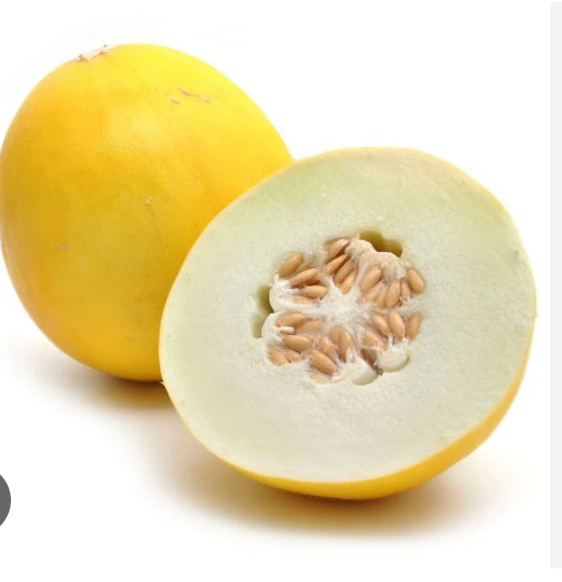
Golden melon belong to the family Cucurbitaceae with sweet, edible, and fleshy fruit. Other fruits in these family include: Cabasa melon, Canary melon, Golden king melon, Cantaloupe, cucumber, water melon, ‘Egusi’ melon, gourd, pumpkin and squash. The word “melon” can refer to either the plant or specifically to the fruit. Botanically, a melon is a kind of berry, specifically a “pepo”.
Golden melon is one of the kinds of melon. It originate from Europe and Africa. It has now spread all over the whole world. It is called different names such as yellow melon, Asian melon, honeydew melon, and sweet melon etc.
Golden melon fruits are oval shaped and have a deep golden color with white stripes. The flesh is white and thick, crisp and very sweet. They are medium-sized averaging 15 to 22 centimeters in length, and can weigh from 4 to 8 pounds.
It has a mild, sweet, fruity taste. Additionally, the flesh of the different varieties have texture that’s quite unlike other melon varieties. It’s crispness is similar almost like eating an apple. It can be season and even combined with other fruits to get a fruit salad or a multi-fruity smoothie.
CHARACTERISTICS AND BENEFITS OF GOLDEN MELON
1. Golden honeydew melons are a medium-sized varietal, averaging 15 to 22 centimeters in length, 2. It has a round to oval appearance,
3. It weighs 4 to 8 pounds.
4. The melon’s rind is thin, bright yellow, firm, and smooth with shallow striations.
5. The melon has yellow skin that contains antioxidants. The antioxidants is more than that of the skin of watermelon and cucumber
6. It also contain flavonoid. Flovonoids improve cardiovascular health and it is shown to have antibacterial properties.

7. The flesh is usually white or light yellow and has a sweet and gentle flavor. It is very juicy and can re-hydrate the body when eaten.
8. The seeds are also edible. They contain a lot of polyunsaturated fats and it has being discovered to have medicinal values.
9. It has low calories and high water content.
10. It also contains a lot of minerals and vitamins. For example, potassium, vitamin C, calcium, and folate. The potassium helps improve heartbeat. The vitamin C boosts the immune system and keeps illness at bay.
11. It can be consumed with the skin which gives the body access to some antioxidants ( vitamin B, Thiamin and niacin) that are beneficial to the body. They help clear the system from toxins.
12. Its skin is thinner than that of other melons
13. It minimizes the impact of ulcers on patients due to its high water content.
14. Due to its low calorie content, it also assists in weight loss. It is low in sugar (6%) and no cholesterol, but high in fiber. This gives reason why it is highly recommended for diabetes patient.
15. It contains Omega 3 and Omega 6 content.
16. It is usually recommended to pregnant mothers because It contains folic acid, which is beneficial to fetal health.
17. It is a Copper source. The Copper aids in skin rejuvenation, leaving it supple and lustrous.
18. The seeds of golden melon can be dried, roasted, and used for snack, or pressed into seed oil. Also, the Seeds can be sown in order to produce fruit.
19. It has a scent that is similar to the wild mango found in the southwest of Nigeria,
20. The seed is rich in nutrients such as calcium, manganese, zinc, iron, copper, and a variety of vitamins. It may be eaten raw or roasted.
BOTANY:
Golden melon does well in tropical to sub-tropical regions. They are annuals, meaning they grow and complete their entire lifecycle in a single year. Like all annuals, they are herbaceous and have little to no woody parts.
THE STEM: The stem is soft, flexible, and green. Due to their long, thin, and weak stems, golden melons cannot grow upright, they are “climbers.” The climbing stem have additional structures like tendrils, which they use to latch onto external support and manage to grow vertically.
FLOWER: Golden melon is a monoecious berry. Both the male and female flowers are supported on the same plant, and can weigh between 700g and 4kg. The flowers are yellow in colour.
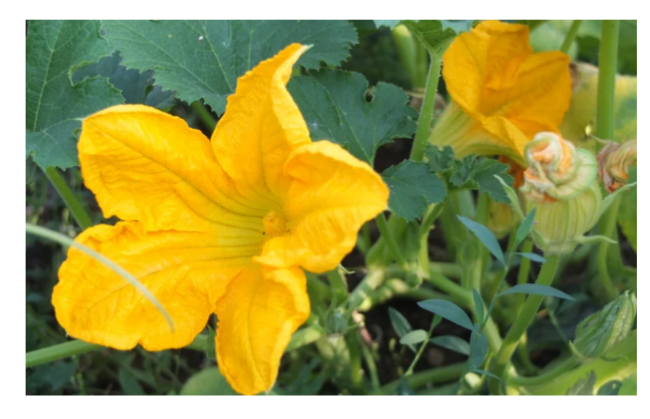
AGRONOMY OF GOLDEN MELON
A. CLIMATIC REQUIREMENT :
i. TEMPERATURE : Golden melon grow best in warm weather. It require a relatively high temperature for optimum production. For outdoor production, it requires a ground temperature of above 70 °F (21 °C) before planting, or else the seeds will not germinate
ii. HUMIDITY: It does not necessarily need humid because humidity can affect production and quality. But in greenhouse, during hot weather, water can be poured on the ground of the greenhouse and allowed to evaporate to keep the indoor environment cool.
iii. SUNLIGHT: Light is a factor that significantly affects the fast growth of golden melons. It requires plenty of sunshine. The light must not be accompanied by excessively high temperatures as this is not beneficial for production of the melon. In the greenhouses, the lack of light accompanied by heavy rains can greatly affect the setting of the melon and considerably reducing the yield. At out door, golden melon should not be grown under the shade but grown under sunny location. The seedlings need full sunshine and plenty of warmth during the day.
PROPAGATION: Golden melon are usually propagated by seed or atimes by stem grafting. The seeds are extracted from a disease free fruit, rinsed in water and air dried for few days. The seeds can be stored if not planting immediately. Also, seeds can be purchased from a reliable seed stores. Such seeds are treated seeds. Any fruit produced from these seeds are used as source of seeds.
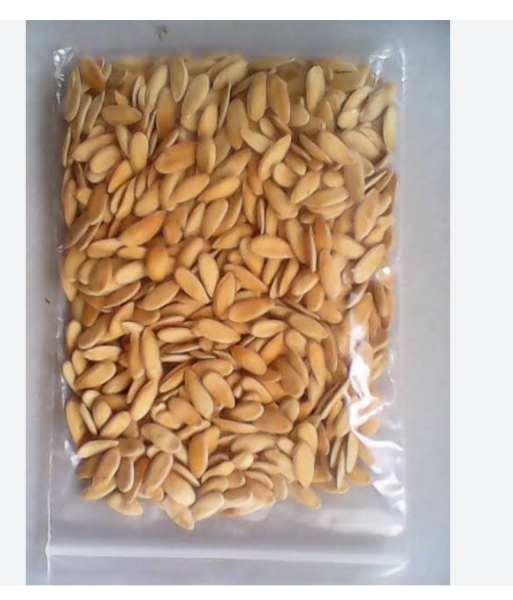
SOIL REQUIREMENT : The suitable soil for golden melon is loamy soil that is fertile and free-draining. For nursery or greenhouse soils, the soil must be kept warm for several weeks ahead of planting by covering it with cloches or biodegradable membrane.
NURSERY PLANTING: It is best to start germinating golden melon seeds indoors in greenhouse, polytunnels or nursery. The seeds should be planted in containers or planting trays of compost and peat moss. After 3- 4 weeks of germination, the seedlings would have produced three or four leaves and be transplanted outdoor on the field. Watering should be done constantly in the nursery.
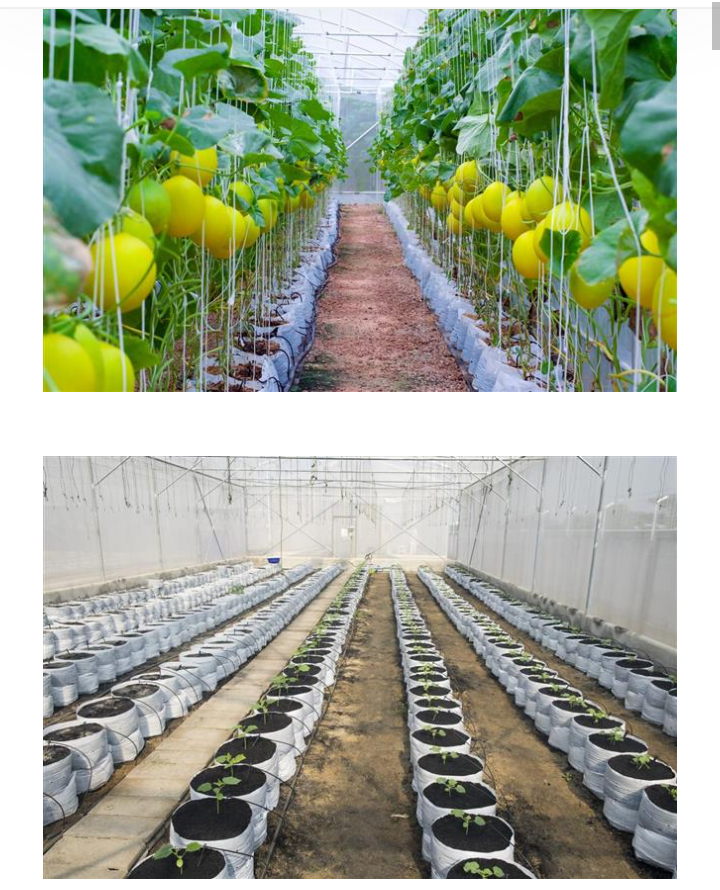
LAND PREPARATION: Golden melon plant can either be grown in the greenhouse or on the field.
On the field, the area of land should be cleared free from all vegetation. Sufficient space should be cleared for the plant beds or mounds and all sticks or rocks in the vicinity should be removed. The clods and lumps in the plant beds or mounds should be broken up with a shovel or a tiller to loosen the soil.
When constructing the mounds or plant beds, the mound should be approximately 1 foot (30 cm) high, and between 2–3 feet (60-90 cm) wide. A space of about 1–2 feet (30-60 cm) should be left between each mound, and space rows of about 4 feet ( 1m) apart to ensure the melon vines have plenty of space to grow.
PLANTING DATE: Melon seeds will not germinate if the soil temperature is less than 70 °F(<21°C). In most temperate locations, planting start sometime between late May and early June. In tropical region, planting starts at early rain, that is March to April. Melon plants do not survive frost and seeds are unlikely to germinate if the soil gets too cold. The soil must be dry before planting the seeds.
PLANTING OR SOWING: If seeds are sown directly outdoor, 5-6 seeds should be sown in each mound. The seeds should be planted between 10-15 cm depht into the mounds. For seedlings raised in nurseries or those purchased, 2-3 seedlings should be planted per mound. But if seedlings are transplanted to planting beds, plants should be spaced at least 90cm (3ft) apart if trailing, and 45cm (18in) apart if growing up supports. Immediately after planting, irrigate the soil with water.
POLLINATION: Melons produce separate male and female flowers, so there is need to transfer pollen from a male flower to a female flower for a fruit to develop. It’s easy to recognise a female flower, as it has a small fruitlet behind it, while male flowers do not.
When growing golden melon indoor like in greenhouse, melon flowers may need to be pollinated by hand. Once one fruit starts to form on the vine, further fruits development can be halted. To avoid this, the plants should be kept covered until several flowers are opened, then ventilate to allow insects in pollination.
Limiting the number of melons fruits per plant helps to ensure the fruits grow to a reasonable size and ripen well. The fruits should be removed when they are at the size of walnut. About four to six fruits should be left on a greenhouse plant and up to four on an outdoor plant, which is usually the maximum number that will ripen by the end of the season.
MULCHING: When seeds are sown, mulch or landscaping fabric, or row covers should be carried out. This is important especially at cooler climate. The mulch will help preserve the heat in the soil and keep the seedlings warm. Also, plant rows can be covered with floating row covers to preserve heat while protecting the seedlings from pests.
Also, immediately after transplanting seedlings, insulation using mulching materials should be done to ensure that the plants are warm enough to grow properly. If the stems are trailing on the ground, the soil should be covered with biodegradable membrane.
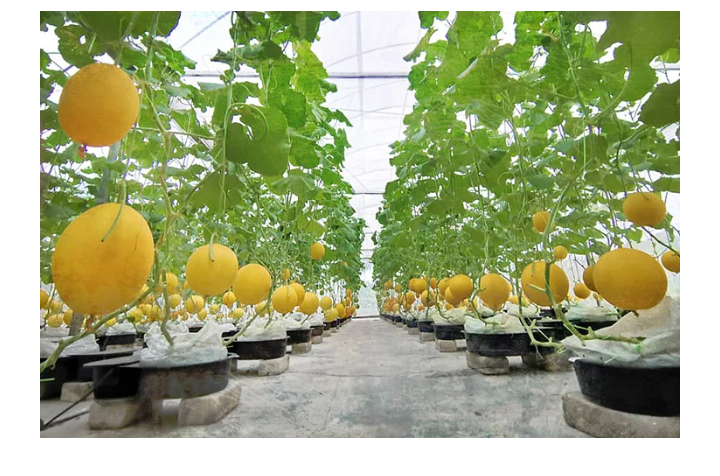
TRAINING OR SUPPORT FOR THE VINE
Golden melon vines should not be left creeping on the ground but supported vertically in the air.
Growing them vertically means they take up little ground space, which is particularly useful in a greenhouse. Suitable supports include sturdy bamboo canes, netting, vertical strings or trellis, which their tendrils can twine around. Melons can make large plants and the fruits can be heavy, so the supports must be strong and well anchored. Melon plants that trail on the ground can take up a lot of space, and are more vulnerable to slugs and snails. Therefore, seedlings should be protected.
For greenhouse production, technique like trellising can be used to grow golden melon. This technique consists of guiding the plant for optimum growth. It offers very positive results in the production of golden melon, as it increases the quality of the fruit. Also, staking technique can be used in the greenhouse. Stakes are constructed for the vines to climb. This eliminate in time the fruit that is not in good condition so that the melons that grow will always be of high quality.
The following steps are taken when training the stems. When growing vertically, a single main stem can be wound to grow up the support, then the side-shoots should be trained horizontally. When the main stem has produced seven to nine leaves, the tip should be pinched out to encourage flowering shoots to develop. Alternatively, once the young plant has five leaves, the growing tip should be pinched out to encourage side-shoots. When the shoots appear, the four strongest shoots should be kept and any other removed. These shoots can then be grown up supports or can trail on the ground. If growing in a large coldframe, the four shoots should be arranged in an X-shape.
FERTILISER REQUIREMENT : Before application of fertilizer, soil test should be carried out. Golden melon requires a soil with pH between 6.0 and 6.8. The soil must have sufficient calcium levels in it. Once the pH levels is correct, fertilizer application can be done. Compost or a natural fertilizer can be applied to the nursery or home and garden store. This ensures that melons are planted in a nutrient-dense environment.
When the fruits are the size of walnuts, apply potassium fertilizer once a week to enhance the fruit development.
IRRIGATION : It is important to water golden melon plants regularly and consistently, especially when the fruits are starting to develop. The melon plants should be watered every 2 to 3 days throughout the dry season when there is shortage or no rainfall or during summer. The aim is to keep the soil or potting compost evenly moist but not saturated. Golden melon plants need at least 2.5 – 5.1 cm of water per week.
Care should be taken not to overwater the plants, as this can cause the melons to rot. If water is standing on top of the soil, some mulch should be added around the melon plants to help absorb it. As melon fruits and begin to ripen, less water should be applied to the melons as this will allow the fruit to develop more flavor and sweetness.
PEST AND DISEASES OF GOLDEN MELON
The melon should be monitored for signs of pests or disease.
PESTS:
a. BUGS OR INSECTS.
CONTROL: Use row covers to keep them away.
b. APHIDS
CONTROL : Spray a diluted insecticide on your plants early in the morning. Repeat as needed.
c. CUCUMBER BEETLES
CONTROL: Set insect traps for them or apply a pyrethrins mix to the soil. Alternatively, use black plastic instead of mulch to protect the plants and keep the pests away.
Other pest include snails, slugs etc
DISEASES
a. POWDERY MILDEW :
SYMPTOMS : White, powdery patches or spots on the leaves or stems of the plants.
TREARTMENT: All plant parts that appear affected should be removed and the rest of the garden should be sprayed with a fungicide or diluted copper spray
HARVESTING : Golden melon fruits are harvested when ripe. The melon spend 3 to 4 months from sowing of seeds to harvesting. The melons become ripe and ready for harvesting when skin begins to produce their characteristic melon fragrance and start to crack near the stem. Then the melons are picked from the vine. Leaving the melons on shelf for too long result in them getting softer, but not sweeter.
If harvested melons are not eaten immediately after harvest, they can be stored in the refrigerator for up to 12-15 days.
